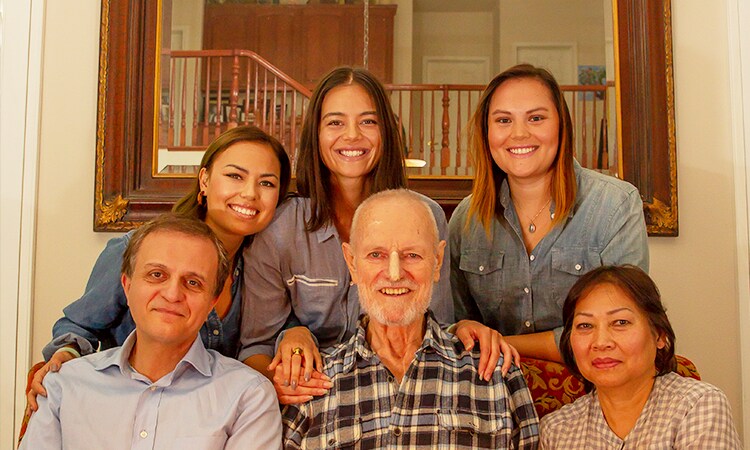William Wilroy - 200 Critical Steps, One Successful Outcome

William Wilroy had just returned home from having a CT scan on his lower abdomen and chest when the phone rang. On the line was a doctor, who viewed the images moments before and urged Wilroy to get to the closest ER via ambulance.
A few hours later, he was at Henry Mayo Newhall Hospital where he was diagnosed with an “Aortic Dissection of the Ascending Aorta (AAA),” or a tear in the lining of the aorta. (The aorta is the main artery in the body. It distributes blood to all parts of the body.) Blood surges through the tear, causing the inner and middle layers of the aorta to separate (dissect). If the blood-filled channel ruptures through the outside aortic wall, aortic dissection is often fatal.
By the time Wilroy arrived in Henry Mayo’s emergency department his aortic wall was so full of blood that it was nine centimeters wide – about three times greater than normal (think of an overinflated tire.)
Dr. Farshad Malekmehr, a cardiovascular thoracic surgeon at Henry Mayo, operated on Wilroy to save his life.
“I do all kinds of surgery but Mr. Wilroy’s case was as complicated as they get” said Dr. Malekmehr.
“This operation had about 200 critical steps,” Dr. Malekmehr continued. “During one critical step we had to stop blood flow to Mr. Wilroy’s brain. Then we had only 30 minutes to repair torn blood vessels leading to his brain. There’s great risk of the patient having a stroke or other neurological damage. Every minute counts.
“In fact, during the entire operation it’s critical that the entire surgical staff is working efficiently and in sync,” Dr. Malekmehr said.
What’s more, Mr. Wilroy was on three different kinds of blood thinners at the time of the surgery. This made it immensely more complicated. “His internal bleeding was so rapid that we couldn’t pump blood into him fast enough, said Dr. Malekmehr. “ He wound up taking 38 units of blood. “
Mr. Wilroy’ surgery took over 12 hours. After the surgery it was a matter of waiting for him to wake up and then determine if he had suffered any neurological damage.
“I remember telling my sister, who was in Europe, that ‘we’ll just have to wait and see,’” said Wilroy’s daughter Evelyn.
When he awoke Mr. Wilroy was asked a series of basic questions to assess his neurological function. He answered all of them correctly, but it was only when he answered a political question with a wisecrack did his family breathe a sigh of relief.
Emergency surgery was the furthest thing from the Saugus resident’s mind when he went to the doctor last summer to see what was causing his weight loss and chest pains, although AAAs often don’t cause signs or symptoms unless they rupture.
“I felt some pain, but I didn’t see an urgency to go to the doctor,” says Wilroy, 81, an accountant, who is married with three grown daughters. “Then, all in one day, I went from the CT scan to surgery.”
He later learned the procedure he had in July 2017 had a 20 percent survival rate, “and that’s for people half my age who are not on blood thinners.” Wilroy continues to make good progress on his recovery, transitioning from a wheel chair to a walker and now a cane. But most importantly, his mind is as sharp as it was prior to the surgery.
“The team at Henry Mayo absolutely saved my life. I wouldn’t be here if it weren’t for Dr. Malekmehr, the nurses and medical team at the hospital,” he says.
“To save his life I drew on my 20 years of experience, and all my training, and all my skills,” said Dr. Malekmehr. “I’m delighted to see how well he’s doing.”
Evelyn added, “The whole thing is a miracle. We’re lucky that he had tests that day, our insurance (provider) recommended we go to Henry Mayo and Dr. Malekmehr was available to do the surgery. It was the perfect timing – any later and he wouldn’t be here today.
“There are no words to express how grateful we are -- everyone at Henry Mayo was on top of it and amazing. They were there every step of the way.”